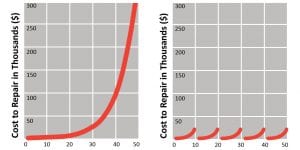In part 1 of this post, we made the case that deferred building maintenance threatens building owners with a curve of costs that can soar out of control if not headed off. But just how does regular, proactive maintenance of building systems “flatten” the cost curve to save money and manage liability?
For most building systems, the rate of deterioration is roughly proportional to the age of the system. Mathematically, this means that the system’s level of deterioration at any time is proportional to the square of the system’s age.
These graphs depict two distinct approaches to maintaining a typical parapet wall (introduced in Part 1):

The graph on the left illustrates the alarming consequences of ignoring the parapet’s condition for fifty years—diplomatically, “deferred maintenance.” The cost to restore the system to its original condition after five decades of neglect is $300,000. This includes reinforcement of the steel spandrel beam, masonry reconstruction, and replacement of coping stones.
The graph on the right illustrates the results—and profound benefits—of inspection and maintenance performed every ten years. After the first decade, the cost to restore the system to its original condition (replacement of coping caulking, repair of cracked masonry, and masonry repointing) is $30,000. After such proactive maintenance, the cost-to-repair graph is “reset,” so that ten years later, the cost is once again $30,000 ($150,000 over 50 years). This means that, between the scenarios represented on the left and right, there’s a 50% cost savings of $150,000! Few other decisions an owner can make offer savings of such magnitude.
The left graph helps answer a common query from managing agents: “Why has the building’s condition become so much worse in just the past few years?” It’s because, with deferred maintenance, the graph “takes off” over time at an accelerating rate, so the deterioration curve becomes precipitously steep. Systems fail with less warning, sometimes with catastrophic consequences—pieces of parapet fall to the street, sidewalk vault structures collapse, or drain lines burst and cause damaging water infiltration.
Clearly, any of these failures can constitute danger and inconvenience to a building’s occupants, hazards to bystanders, and serious liability issues for the building owner or manager. When the deterioration curve is effectively flattened, both occupants and owner are better protected. The conclusion is clear: In the long run, regular maintenance pays for itself—and then some.
14 Wall Street, 25th Floor, New York, NY 10005
(212) 505 1133
info@superstructures.com
Subscribe to SuperScript, our email newsletter.